May 4, 2021
May – Water Safety Month
Water Safety Month is here. With the start of Summer right around the corner, it’s time to start thinking about FUN IN THE SUN! You’ve been waiting for it – Now ENJOY IT!!
You want all your family and friends to be safe, and you would never allow an injury to occur. Let your family enjoy the entire Summer on the water! Here are some helpful tips to keep you in the sun all Summer long!
For Safety – Always wear a life jacket!
Whether you’re on a boat or a personal watercraft, always wear a personal flotation device for personal safety. Young children should always wear life jackets anytime they are in or on the water. A life jacket is the first line of defense against drownings.
They will insist that they can swim so they don’t need one. Can you ensure there will be no leg cramps or a head injury? Either of these would render them unable to “swim like the fish they think they are”? Don’t give in! YOU are the ADULT. Make them wear a floatation device for their safety.
Ensure that the life jacket fits snugly but comfortably. Make sure it cannot slip above the chin or ears when tugged on at the shoulders. Life jackets must be worn correctly to keep them safe.
Do you really want to find out what it’s like to lose a child, a friend, or a grandchild? Be the adult and insist they wear a life jacket.
Pay Attention to the Weather
Summer weather can change. Severe weather can crop up quickly and escalate even faster. For everyones safety, pay attention to weather forecasts and the skies. Don’t get caught on a lake when the weather goes from sunny to stormy.
Always wear sunscreen!
Today, we are all aware of the danger we incur when the sun is out. The reflection off the water and wet skin amplify the sun’s intensity. Protect yourself from harmful UV rays.
Drinking and Boating Don’t Mix.
A cool beverage can be refreshing on a hot Summer day but don’t drink and drive a boat. Consuming alcohol impairs your judgment. It slows your reflexes, making it harder for you to steer, swim and assist those around you. If you want to have a cool beverage, do it from the safety of the shoreline.
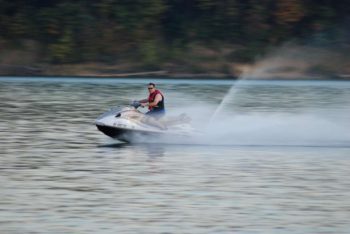
May-Water Safety Month
In Wisconsin, you will get a traffic citation for operating a boat while under the influence. Even using a PWC under the influence will get you a ticket.
Speaking of a PWC – everyone loves to race a boat or another PWC. It is easy to lose control and get thrown off the PWC. Maintain at least 100 feet from a dock and between any water vessel and 200 feet of the shoreline.
Read this state approved handbook – page 26 for additional regulations. A citation for operating in an unsafe manner will spoil your day.
A general rule of thumb is – if the state law does not allow you to drive a vehicle in that manner – it’s probably illegal on the water too.
For safety – Keep Your Speed Down and Pay Attention
The lakes and waterways can get very busy in the Summer months. Watch out for other boats, swimmers, tubers, and skiers. Maintain a safe speed and always practice defensive driving. Not sure what the other guy is going to do? – stay clear!
Keep an eye out for boats and swimmers in distress.
Use the Buddy System for Safety
Bring a buddy with you – it’s more fun and safer! Even experienced swimmers can get into a dangerous situation and need help.
Make National Water Safety Month an excellent experience for everyone.
Where can I find Pier & Waterfront Solutions?
Pier & Waterfront Solutions, 7325 St. Hwy 57, is located 3 miles south of Sturgeon Bay. Go 1 mile PAST the intersection with County MM (heading north). Look on the right at the next corner – Idlewild Road and Hwy 57.

Pier & Waterfront Solutions remains “open” year-round.
The Covid-19 virus continues to spread and affects many people. We are conducting as much business as possible by email, text, or phone.
Site visits continue as usual. When making in-person contacts, we follow “social distancing” guidelines when possible.
PWS display yard – OPEN 24-7
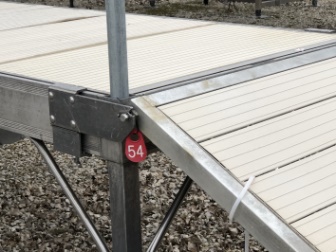
Red Tag
PWS‘s display area is always open for you to examine at your leisure. All displays available for sale have a numbered, red tag on them. Want more information on something you saw in our yard? Please reference that number when you inquire.
PWS provides estimates by email to make the process faster, safer, and paperless.
Call, message, or email Jerry with any questions.

Jerry Englebert
Contact Jerry at 920-493-4404 for more information or use this link.
Jun 16, 2020
A Boat Lift Safety Lesson
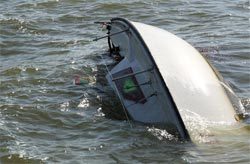
My lift cable broke…and I can’t ….
Proper boat lift safety means you won’t have to learn the tough lesson pictured here. If you apply these recommendations, you can relax and enjoy your boating experience.
Failure to follow these safety suggestions may result in damage to your boat or even personal injury.
Boat Lift Safety = Never exceeding the Ratings
The rated capacity of any lift is the maximum capacity, and you should never exceed that amount.
Boat weight INCLUDES more than just the published weight of the boat. It also includes the weight of fuel, water, and equipment. After all, you will be lifting all of this when you raise your boat. It adds up very quickly!
Plus, we recommend that you allow at least a 300-500# margin of error when you calculate the boat weight. See also: Sizing a Boatlifts: How to select the correct Boat Lift.
If you ever hear a salesperson say, “You can easily go 40% or 50% over that rating without a problem”. You are at risk of being the owner of the boat above if you follow that flawed thinking.
What’s the real story?
Lift cables are rated much higher than the rating of the boat lift. As an example, (using imaginary numbers) your boat lift has a 4,000# rating, it could have cables rated for 6,000# to 8,000#.
The cable rating may be 6,000#, but ONLY if the wires are in perfect shape – meaning no burrs, kinks, frays, or rust. These defects reduce the load capacity of the cables.
The lift racks are correctly rated for the weight regardless of the cable ratings. If someone is trying to sell you a 4,000# lift and telling you that it can handle up to 4,700# – WALK AWAY!!
The load must also be “balanced” on the rack for proper boat lift safety. (More on this later)
Lift cables fail without warning
Sorry!! Cables don’t “creak” or “groan” as a warning of impending danger. The only sound you hear is a loud “snap” followed by the sound of your boat hitting the water.
In a storm, you want to get your boat as high above the water as possible. Yet, raising a boat until the lifting platform or rack hits the frame is NOT the way to do it.
Hitting the frame is an all too common occurrence. Ask yourself, if raising the boat that extra ½” is worth snapping a cable. You risk damage to your boat and lift, or worse yet, personal injury.
Operate Lift Motors properly or break a cable
Properly used, an electric lift motor is a real back saver! I wouldn’t be without one. But you need to exercise extra care when using a lift motor. Shutting off a lift motor does not mean the lifting action will stop. What if it “drifts”?
For example, one brand of lift motor “drifts” after the motor stops. The “drift” potentially causes the lift rack and frame to jam together.
Cable failure, lift or boat damage, personal injury, or worse may be the result.
When the rack hits the lift frame, something has to give. The most likely culprit will be the cables. If you combine a damaged cable with a rack hitting the frame, you have a recipe for disaster.
OK, You Jammed the Rack & Frame! – What comes next?
You were distracted, and now the rack is jammed against the frame. A jammed rack means your next step is critical.
You’re in a hurry to release the pressure, but be sure you know which way the motor will go when you flip the switch.
If the rack isn’t going “DOWN,” damage occurs almost instantly. If it is a broken cable – your boat goes down – even faster!! Starting the winch or motor in the wrong direction could mean your boat will be in the water in an instant. Did I mention it won’t be floating?
Proper Positioning of the boat is part of boat lift safety.
As if a jammed rack wasn’t enough, did you know there are right ways and wrong ways to position your boat on your lift?
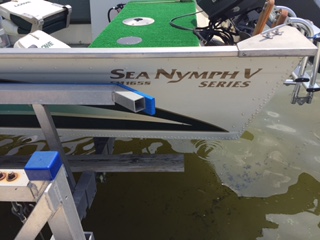
Boat stern overhanging too far
All lift ratings are based on a “balanced load.” In other words, the weight of the boat must be relatively equal on each end of the rack.
When you put the majority of the weight on one end of the rack, cable breakage is more likely.
The heaviest part of any boat will be where the engine is mounted. That could be at the stern (outboards) or even near the middle of the boat (inboards).
A boat placed too far forward on the lift rack results in excessive weight on the “front” of the lift. Too far to the stern of the boat puts too much weight on the rear cables. If the cables have weakened by corrosion or fraying, you risk impending disaster.
What is the correct position for a boat on a lift?
You can determine the proper positioning of a boat by placing the stern of the boat within 12″ – 18″ of the rear lift rack. Now, raise the rack slightly out of the water.
Next, try to lift the bow end with your hands. If the boat weighs 3,500# and you can lift the front of the boat, you are either “Mr. Atlas” or the boat is positioned to the rear. If you can lift the bow at all, your boat is too far back. The weight is not evenly distributed across the four corners of the lift. Lower the boat and reposition it forward.
The boat shown here overhangs about 36″ from the rack and risking major damage. By placing the boat too far back on the rack, a majority of the weight is on the rear cables. What if those cables are weak from corrosion or fraying?
Does high water affect the positioning of a boat?
Yes, it does. In the example above, with the rear of the rack overloaded, the boat has only minimal weight on the front rack.
Your boat will float on a wave. When the bottom of the boat is “lapped” by a wave, it will try to raise the boat. With repeated lifting (or bouncing) the boat can work it’s way off the rack. It will try to go go to the rear. Eventually, the boat will literally “bounce” right off the lift.
With a balanced boat, you have a better chance of the boat staying on the rack.
Align the boat in the same position each time.
So, now you have repositioned your boat until you found a good position for a balanced load. What comes next?
It’s time to make a note of a fixed object on the boat and how it lines up with something on the lift. This is a good gauge for the next time you enter your lift. Always try to go back to this same position.
Summary
You now know the do’s and don’t of boat lift ratings and positioning for your boat. With this knowledge, you can Relax and Enjoy your boating experience.
Where is Pier & Waterfront Solutions?
Located at 7325 St. Hwy 57, it’s 3 miles south of Sturgeon Bay, and 1 mile past the intersection of Cty MM (heading north). Look on the right side, one mile north, at the next intersection (Idlewild Road and Hwy 57).
ARE WE OPEN?
During this time of uncertainty, Pier & Waterfront Solutions is staying “open.” We have implemented measures to ensure the safety of our employees and visitors. At the same time, we are working to maintain the trusted service that you have come to expect.
We are implementing these precautionary measures:
1. Conducting as much business as possible by email, text, or phone.
2. Site visits will continue but with limited in-person meetings. When in-person contacts are necessary, we will follow “social distancing” guidelines.
3. Our display yard is always open for you to examine at your leisure. All displays have a numbered, red tag on them. If you want more information or pricing, please reference that number.
That’s not all!
4. Some employees are working remotely, but they are always available by phone.
5. Any employee exhibiting symptoms or illness is sent home.
6. We provide estimates and invoices by email to make the process paperless and faster.
7. Crew starting times are being staggered to limit social interactions.
8. We keep the same crews together to limit cross interactions.
With these measures, we hope everyone will stay safe, and we will be back to normal operations soon.
What can YOU do to help us?
1. Please conduct as much business as possible via emails, messaging, and emails. This step protects everyone involved.
2. When you see our crews installing equipment, please practice “social distancing.”
So, YES – WE ARE OPEN!
Please call, message, or email us with any questions.
Thank you for allowing us to work with you.
Let’s all stay safe!
Contact:
Jerry @ (920) 493-4404 or Jerry@wisconsinpws.com – Commercial work & new/used Sales.
Dave @ (920) 905-2588 or Dave@wisconsinpws.com – Erosion control & shoreline work.
Jerry @ (920) 493-4404 or Jerry@wisconsinpws.com – Scheduling & Service work
May 26, 2020
10 Best Boat Docking tips
Docking a boat or putting it into a boat lift is not the favorite activity for any boater. Until you feel confident about what you are doing, it can be down-right terrifying. It was so easy to go out. – why can’t it be just as simple to come back in?
Follow the best boat docking tips shown here and it will make it easier for any boater.
- Always put safety first. Check the surrounding area before approaching a dock. Kids love to swim under the dock to greet you.
- VERY IMPORTANT – How fast are you going? Are the waves pushing you too fast? Are you willing to hit the dock or boat lift at that speed?
- Remember – Slow speeds will always give you more time to correct your course. Slower speeds also cause less damage. On the flip side, it is harder to control the boat at slower speeds.
Follow the next steps for greater control:
- Always turn the wheel BEFORE applying any power – not during or after. This is very important for a single-engine boat.
Note – Twin inboards? Keep your hands off the wheel with twin inboards. If you do turn the wheel, the boat may take an unexpected path when you try to use the engines.
- Apply short bursts instead of steady power to the engine. You won’t build up a lot of momentum, and you will have better control of the boat. Speed and momentum are the opposite of control.
- Always stay under power. Without power, you can not control the direction of the boat. Keep the engine on so you can maneuver as necessary.
- Secure all ropes and make sure they are not wrapped around anyone’s hands or feet.
- Always communicate with passengers as you approach the dock. Managing your crew or guests before and during docking is important to make docking safer.
- Always reduce your windage in heavy winds. Particularly in a small boat.
- Don’t worry about stopping and doing it over again. If you see a problem, it’s better to reverse the motor than hit something. On your next pass, it may be better – come back for another try.
Tell Your Friends & Family
Have friends or neighbors you believe should see this article? Email them this link – and Thank you!
Where is Pier & Waterfront Solutions?
Located at 7325 St. Hwy 57, it’s 3 miles south of Sturgeon Bay, and 1 mile past the intersection of Cty MM (heading north). Look on the right side, one mile north at the next intersection (Idlewild Road and Hwy 57).
We look forward to talking to you.
ARE WE OPEN?
During this time of uncertainty, Pier & Waterfront Solutions is staying “open.” We have implemented measures to ensure the safety of our employees and visitors. At the same time, we are working to maintain the trusted service that you have come to expect.
We are implementing these precautionary measures:
1. Conducting as much business as possible by email, text, or phone.
2. Site visits will continue but with limited in-person meetings. When in-person contacts are necessary, we will follow “social distancing” guidelines.
3. Our display yard is always open for you to examine at your leisure. All displays have a numbered, red tag on them. If you want more information or pricing, please reference that number.
Is there More?
4. Some employees will be working remotely, but they are always available by phone.
5. Any employee with symptoms or illness is sent home.
6. We continue to provide estimates and invoices by email to make the process paperless.
7. Crew starting times are being staggered to limit social interactions.
8. We keep the same crews together to limit cross interactions.
With these measures, we hope everyone will stay safe, and we will be back to normal operations soon.
What can you do to help us?
1. Please conduct as much business as possible via emails, messaging, and emails. This step protects everyone involved.
2. When you see our crews installing equipment, please practice “social distancing.”
Thank you for allowing us to work with you.
So – YES – ARE WE OPEN?
Please call, message, or email us with any questions.
Let’s all stay safe!
Contact:
Jerry @ (920) 493-4404 or Jerry@wisconsinpws.com – Commercial work & new/used Sales.
Dave @ (920) 905-2588 or Dave@wisconsinpws.com – Erosion control & shoreline work.
Jerry @ (920) 493-4404 or Jerry@wisconsinpws.com – Scheduling & Service work
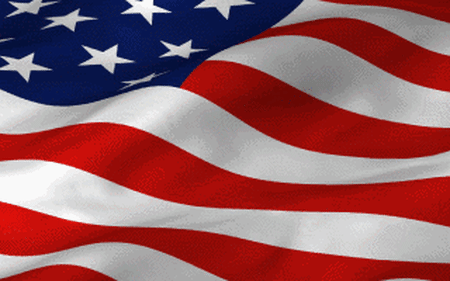
Jul 2, 2019
JULY 4 th IS ALMOST HERE
July 4 th is something we all look forward to each year. There are fireworks, family reunions, and making new friends.

Making a new friend on July 4 th
This year we especially look forward to the four day weekend it brings with it. If Mother Nature cooperates with us, it should be a great weekend.
July 4 th Door County Happenings
Check this article out for a list of July 4 th activities.
However, let’s not forget what July 4th also brings with it. Generally, the boat traffic is substantial all through the weekend. There will be lots of water skiing and boating going on. Not to mention the parties.
Safety Tips
Some safety tips that we must all be aware of are:
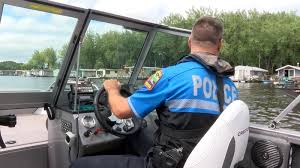
Boat Safety Rule #3- Don’t get a visit from him
1. Choose a designated driver. It’s not just for cars. The DNR and law enforcement will be out in force trying to protect you.
2. Don’t allow anyone under the influence to swim alone.
3. Be especially mindful of kids. That means your kids or grandkids and also the neighbors. Kids know no boundaries.
4. Fireworks on boats are a real danger. You have fuel and many flammable items on a boat. Besides, people are in close proximity even a pontoon boat. Leave the fireworks to the professionals.
5. The weather to date has been colder than average, and many of the trees are way behind. Did you know, if you are in an area where there are poplar trees, and you see those fuzzy white balls floating in the air and clinging to your lawn, they present danger around camp-fires and fireworks?
How can something so lightweight and harmless be a danger? The author was at campground years back with the ground covered by the fuzz. Someone threw a firecracker on the ground, and the resulting flash instantly caused a fire that moved incredibly fast. Everyone at the campground had to fight the fast-moving flames. It swept rapidly in every direction.
6. Did you know that, in general, the same rules apply when operating a boat as operating a vehicle? You can receive a citation for following too closely, racing a boat or jet ski too closely, driving under the influence, making dangerous maneuvers, not having the proper life preservers (just like a seatbelt), and more.
MANY MORE IDEAS
We could go on and on but if you want more information about safety, consider reading this article. Here are some more 4th of July tips.
We frequently stress safety because it only takes a snap of your fingers for an accident to happen. We don’t want your weekend (or life) ruined by one wrong decision.
Have a safe and enjoyable July 4th holiday
Where can you find Pier & Waterfront Solutions?
We are located in the center of the Door County Peninsula at 7325 St. Hwy 42/57. That’s 1 mile North of County MM (Hwy 42) and 3 miles South of Sturgeon Bay. Look for the Idlewild Road intersection.
Don’t forget – Give us a call If you have a dock or boatlift topic you would like to see addressed on our site.
Call Jerry at 920-493-4404 or Email Jerry@wisconsinpws.com for more information.
Mar 5, 2019
Power Options for Boat Lift Motors
Boat lift Motors are covered in this 2 part series. We discuss the different types of operating systems for boat lift motors. Installing a boat lift motor makes your life so much easier. If you can operate a garage door opener, you can run a boat lift motor.
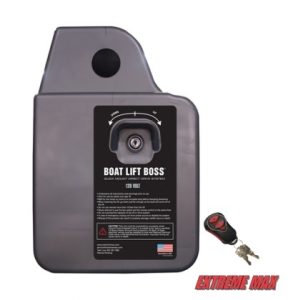
Lift Boss
You have three choices to consider for powering a boat lift motor.
- An A.C. operated system;
- A 12V system; Or
- A 24V system.
PWS does not usually recommend an A.C. powered system. Why? It usually means running an extension cord to the motor. Your safety and the safety of the people near you are our primary concern.
Using an A.C. operated lift motor means the extension cord(s) and the connections will be exposed to the elements. These include – Rain, morning dew, splashing from waves, and the list goes on. As a result, there is a potential to expose people to ESD. For a further explanation read this article.
You could be endangering children (or grandchildren) and even your neighbors to electrical shocks. ESD can be deadly and not only threatens swimmers but the people who attempt to rescue them.
Beside safety reasons what other dangers are there?
First, some background info. The smaller the Gauge (Ga.) size, the heavier the wire is. Thus, a 12 gauge wire has a “heavier” wire than an 18 Ga. Typical household extension cords – those brown or white cords – are 18 – 20 Guage (Ga). The wiring in your house is a 14 Ga. 12 Ga. is used in kitchens and bathrooms due to higher amperage requirements. A smaller diameter wire will have a higher resistance to current flow. Thus, more heat is generated in the wire and connections. You want the least amount of heat as possible.
What is Voltage Drop?
The electrical source you use usually will be a circuit run underground or along poles to a power box near the water. At this point, you probably are thinking – “So what, I’ll just run an extension cord to the motor.” On the bay of Green Bay and the Door County peninsula, in particular, you may be looking at the need for a 100’-200’ extension cord. This likely means a second extension cord and more voltage drop. This will get the power across the shoreline to the location of the motor. This presents some problems.
In reality, the longer the extension cord is, the more “voltage drop” will occur. Think of it this way – to turn that motor you need a specific voltage (110V) and amperage. If you experience a voltage drop due to the length of the extension cord, it will require more amperage or current flow make up for the loss in voltage to operate that motor. This situation causes wires to heat up and motors to run hotter. An overheated motor will trip the breakers and damage the motor.
If you’re starting at 110 volts and the voltage drops 3%, it won’t matter to a small appliance or light bulb that the voltage is now 117 volts. However, if you plug in a 100-foot extension cord, the voltage will drop about 6 percent to 104 volts. The motor will run hotter.
Motors generally need heavier gauge wires, in this case, 12 Ga. You would not plug a window air conditioner into those “brown” 18-20 Ga. extensions cord you find at the supermarket. Even a short 4 ft cord like that will almost instantly trip a breaker – IF you are lucky. A fire will occur if you are not so fortunate.
Motors and Extension Cords do not mix well.
Voltage drops can cause loss of efficiency, and this will mean a shorter life span for the motor. It is essential to use the right gauge of wire when running wires for a long distance and keep the cords as short as possible with as few connections as possible.
Electrical cord Guidelines
The best practice is don’t use an extension cord if you don’t have to. Since this isn’t always practical, follow these guidelines for using extension cords with motors to minimize voltage drop:
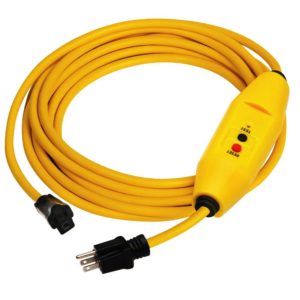
Electrical cord with GFCI device
- Use a GFCIs, or Ground Fault Circuit Interrupters to disconnect power if a potentially dangerous situation occurs. A GFCI interpreter will instantly respond, preventing possible electrocution-related accidents.
- Always use the shortest extension cord possible.
- Use only one cord (there is a voltage drop across the connectors also)
- Use the heaviest Ga. possible – usually a 12 Ga. wire.
- Route extension cords safely and securely. Never place them where they will be damaged or drop into the water.
- If more than one cord is required, use the same on both cords
- Use only extension cords rated for outdoor UV resistance.
- Protect the connectors from the water.
- Do not use damaged cords. Watch out for electrical tape on extension cords.
These are important safety considerations. Choosing the right wire for the job is a critical safety measure.
The best practice is don’t use an extension cord if you don’t have to.
About 50 people die, and 270 people are injured each year when extension cords are strung together.
In part two of this series, we will discuss the two variations for D.C. motors.
Do you have a friend that may be interested in this information? Please share a link to this page with them.
Need Help Selecting a Boat Lift Motor?
PWS is located at 7325 St. Hwy 57. That’s 1 mile North of County MM (Hwy 42) and 3 miles South of Sturgeon Bay at the Idlewild Road intersection.
Our staff is here year-round to assist you.
















